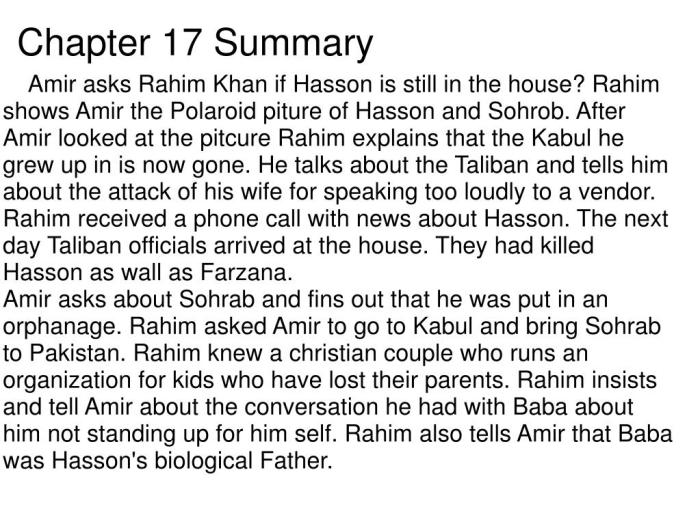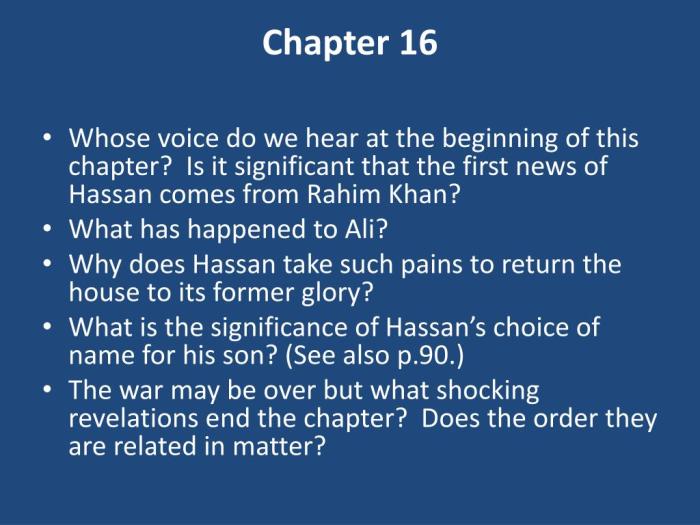Chapter 16 the kite runner – In Chapter 16 of The Kite Runner, Amir and Sohrab’s journey takes a profound turn, delving into themes of redemption, atonement, and the complexities of human relationships. This chapter is a pivotal moment in the novel, exploring the characters’ growth, the power of forgiveness, and the enduring bonds that transcend adversity.
As Amir and Sohrab navigate their newfound connection, they confront their past traumas and the consequences of their actions. The chapter’s rich symbolism, evocative imagery, and introspective narrative style create a deeply moving and thought-provoking experience for readers.
Contextual Overview of Chapter 16

Chapter 16 of The Kite Runner serves as a crucial turning point in the novel’s narrative arc, marking a significant shift in the protagonist’s journey. It brings together several threads that have been developing throughout the story, culminating in a powerful and emotional climax.
The chapter revolves around Amir’s return to Afghanistan after many years of self-imposed exile. Driven by a deep sense of guilt and a desire for redemption, he embarks on a perilous mission to rescue his nephew, Sohrab, from the clutches of the Taliban.
Along the way, he confronts his own past and the choices he has made, leading to a profound transformation in his character.
Themes
Chapter 16 explores several central themes of the novel, including:
- Redemption and Forgiveness:Amir’s journey is a testament to the power of redemption and the possibility of forgiveness, even for the most grievous of sins.
- The Consequences of Past Actions:The chapter highlights the far-reaching consequences of Amir’s past actions, both for himself and those around him.
- The Importance of Family:Despite the challenges and betrayals they have faced, the bond between Amir and Sohrab ultimately proves unbreakable.
- The Resilience of the Human Spirit:Even in the face of adversity and trauma, the human spirit has the capacity to endure and overcome.
Character Analysis

Amir and Sohrab’s characters undergo significant transformations in Chapter 16, deepening their complex relationship.
Amir’s Emotions and Motivations
Amir grapples with a range of emotions, including guilt, shame, and determination. Haunted by his past actions, he seeks redemption by rescuing Sohrab. Driven by a desire to make amends, he confronts Assef and ultimately rescues Sohrab from his clutches.
Sohrab’s Transformation
Sohrab, once a withdrawn and traumatized child, begins to heal and rebuild his life. Through Amir’s care and support, he finds solace and a sense of belonging. He embraces his newfound freedom and gradually overcomes the scars of his past.
Evolving Relationship
Amir and Sohrab’s relationship evolves from a protector-protégé dynamic to a genuine father-son bond. Amir’s unconditional love and Sohrab’s growing trust create a profound connection. They find healing and redemption in each other, proving that even the darkest pasts can give way to a brighter future.
Symbolism and Metaphor
The kite, a central symbol in Chapter 16, represents the complex relationship between Amir and Sohrab. Amir’s decision to fly a kite with Sohrab signifies his attempt to atone for his past sins and reconnect with the son he abandoned.
The kite’s flight also symbolizes hope and redemption, as it soars above the pain and trauma of the past.
Metaphors and Similes
Hosseini uses metaphors and similes throughout the chapter to convey deeper meanings. For instance, Amir’s guilt is described as “a gnawing ache that never went away,” highlighting the persistent nature of his remorse. Sohrab’s resilience is likened to “a tree that had weathered a thousand storms,” suggesting his ability to overcome adversity.
Redemption and Atonement
Chapter 16 explores the themes of redemption and atonement. Amir’s efforts to fly a kite with Sohrab represent his attempt to make amends for his past actions. Through this act, he seeks to redeem himself and find a measure of peace.
The kite’s flight also symbolizes the possibility of healing and reconciliation, as it brings Amir and Sohrab closer together.
Narrative Structure and Style

Chapter 16 of The Kite Runner features a non-linear narrative structure, with frequent flashbacks and foreshadowing. The chapter begins with Amir and Sohrab in the present, but quickly transitions to a flashback recounting Amir’s past experiences in Afghanistan. These flashbacks provide context for Amir’s present actions and motivations, and also foreshadow events that will occur later in the novel.The
author’s use of language, imagery, and tone creates a vivid and emotionally charged atmosphere in Chapter 16. The descriptive language paints a clear picture of the setting and characters, while the use of metaphors and similes evokes powerful emotions. The tone of the chapter is often somber and reflective, as Amir grapples with his past and his present responsibilities.Chapter
Chapter 16 of “The Kite Runner” offers a glimpse into the challenges faced by Afghan immigrants in America, a theme that resonates with “Mr. Pirzada Came to Dine” ( mr pirzada came to dine ). Pirzada’s struggles as an Afghan immigrant in California parallel those of the Afghan characters in “The Kite Runner,” highlighting the complexities of assimilation and the search for identity in a foreign land.
Ultimately, both works explore the resilience and determination of individuals navigating a new and often challenging world.
16 is a crucial turning point in the novel’s narrative flow. It marks the moment when Amir finally confronts his past and begins to take responsibility for his actions. The chapter also sets up the events that will follow in the novel’s climax, as Amir and Sohrab face their greatest challenges yet.
Flashbacks, Chapter 16 the kite runner
The flashbacks in Chapter 16 provide important context for Amir’s present actions and motivations. They reveal his childhood experiences in Afghanistan, including his relationship with Hassan and the events that led to Hassan’s death. These flashbacks help the reader to understand Amir’s complex character and his struggle to come to terms with his past.
Foreshadowing
The foreshadowing in Chapter 16 hints at events that will occur later in the novel. For example, the description of the kite fight foreshadows the upcoming confrontation between Amir and Assef. The mention of Rahim Khan’s letter foreshadows the revelation of Baba’s secret and Amir’s true parentage.
These foreshadowing elements create a sense of suspense and anticipation, and they keep the reader engaged in the story.
Language, Imagery, and Tone
The author’s use of language, imagery, and tone creates a vivid and emotionally charged atmosphere in Chapter 16. The descriptive language paints a clear picture of the setting and characters, while the use of metaphors and similes evokes powerful emotions.
The tone of the chapter is often somber and reflective, as Amir grapples with his past and his present responsibilities.For example, the description of the kite fight uses vivid imagery to create a sense of excitement and danger. The author writes, “The kites danced and swooped in the sky, their colorful tails streaming behind them like the ribbons of a thousand tiny rainbows.”
This imagery helps the reader to visualize the kite fight and to feel the excitement of the participants.The author also uses metaphors and similes to evoke powerful emotions. For example, Amir describes his guilt over Hassan’s death as a “cancer” that is eating away at him.
This metaphor helps the reader to understand the depth of Amir’s guilt and the way it is consuming him.The tone of the chapter is often somber and reflective, as Amir grapples with his past and his present responsibilities. The author uses language that is both evocative and emotionally charged, creating a sense of pathos and empathy for Amir.
Cultural and Historical Context: Chapter 16 The Kite Runner
The events depicted in Chapter 16 of The Kite Runner hold significant cultural and historical importance, reflecting the tumultuous period of the Afghan-Soviet conflict.The Soviet invasion of Afghanistan in 1979 sparked a decade-long war that had a profound impact on the country’s people, society, and infrastructure.
The conflict forced millions of Afghans to flee their homes, becoming refugees in neighboring countries and beyond. The chapter explores the experiences of these refugees, particularly Amir and Rahim Khan, who were forced to leave their homeland and rebuild their lives in a foreign land.
Afghan-Soviet Conflict and its Impact
The Afghan-Soviet conflict had a devastating impact on Afghanistan. The war resulted in the deaths of hundreds of thousands of civilians, the destruction of countless homes and infrastructure, and the displacement of millions of people. The conflict also led to the rise of the Taliban, a fundamentalist Islamic group that imposed a strict interpretation of Sharia law on the country.The
chapter depicts the hardships faced by Afghan refugees during this period. Amir and Rahim Khan, for example, were forced to leave their home in Kabul and flee to Pakistan. They lived in a refugee camp for several years, where they faced poverty, discrimination, and uncertainty about the future.
Themes of Immigration, Exile, and Identity
The chapter also explores themes related to immigration, exile, and identity. Amir and Rahim Khan’s experiences as refugees highlight the challenges and complexities of living in a foreign land. They struggle to adapt to a new culture, language, and way of life, while also grappling with feelings of loss, displacement, and nostalgia.The
chapter also explores the impact of exile on identity. Amir and Rahim Khan are both forced to confront who they are and what it means to be Afghan in a world that has changed dramatically. They must find ways to reconcile their past with their present, and to forge new identities in a foreign land.
Comparative Analysis

Chapter 16 of The Kite Runnerstands out as a pivotal moment in the novel, marking a significant shift in the protagonist’s journey. In this chapter, Amir confronts his past actions and grapples with the consequences of his betrayal. By comparing Chapter 16 to other chapters in the novel, we can gain insights into the novel’s themes, character development, and narrative style.
Similarities and Differences in Themes
Chapter 16 shares several thematic similarities with other chapters in the novel. Like Chapter 7, it explores the theme of redemption and forgiveness. Amir’s decision to rescue Sohrab mirrors his father’s earlier act of rescuing Hassan from Assef, highlighting the power of compassion and the possibility of atonement.
Chapter 16 also delves into the theme of cultural identity, as Amir struggles to reconcile his American and Afghan identities. However, Chapter 16 differs from other chapters in its focus on the consequences of inaction and the weight of guilt.
Amir’s past betrayal of Hassan haunts him throughout the chapter, shaping his decisions and driving him towards redemption.
Character Development
Chapter 16 is a turning point in Amir’s character development. It marks the culmination of his journey of self-discovery and redemption. Throughout the novel, Amir has been grappling with his guilt over betraying Hassan, and in Chapter 16, he finally confronts his past and takes action to make amends.
This act of redemption transforms Amir from a passive observer to an active participant in his own life, demonstrating the transformative power of confronting one’s past.
Narrative Style
The narrative style in Chapter 16 is distinct from other chapters in the novel. While the novel generally employs a third-person omniscient narrator, Chapter 16 shifts to a first-person perspective from Amir’s point of view. This shift allows the reader to experience Amir’s emotions and thoughts firsthand, creating a more intimate and emotionally resonant experience.
The use of flashbacks and foreshadowing in Chapter 16 also adds to the chapter’s intensity and suspense, building towards Amir’s climactic confrontation with Assef.
Contribution to the Novel’s Overall Message and Impact
Chapter 16 plays a crucial role in the novel’s overall message and impact. It serves as a powerful reminder of the consequences of inaction and the importance of confronting one’s past. Through Amir’s journey of redemption, the novel highlights the transformative power of compassion, forgiveness, and the pursuit of justice.
Chapter 16 also contributes to the novel’s exploration of cultural identity and the complexities of belonging. By delving into Amir’s struggles with his Afghan and American identities, the novel sheds light on the challenges faced by immigrants and refugees in search of a place to call home.
Clarifying Questions
What is the significance of the kite in Chapter 16?
The kite symbolizes Amir’s guilt over his past actions and his desire for redemption. It also represents the bond between Amir and Sohrab and their shared journey towards healing.
How does Sohrab’s character develop in Chapter 16?
Sohrab undergoes significant growth in Chapter 16. He begins to heal from the trauma he has experienced and finds solace in his connection with Amir. He also learns to trust and love again.
What is the main theme of Chapter 16?
The main theme of Chapter 16 is redemption and atonement. Amir seeks to atone for his past sins by protecting Sohrab and providing him with a better life. The chapter also explores the power of forgiveness and the importance of human connection.